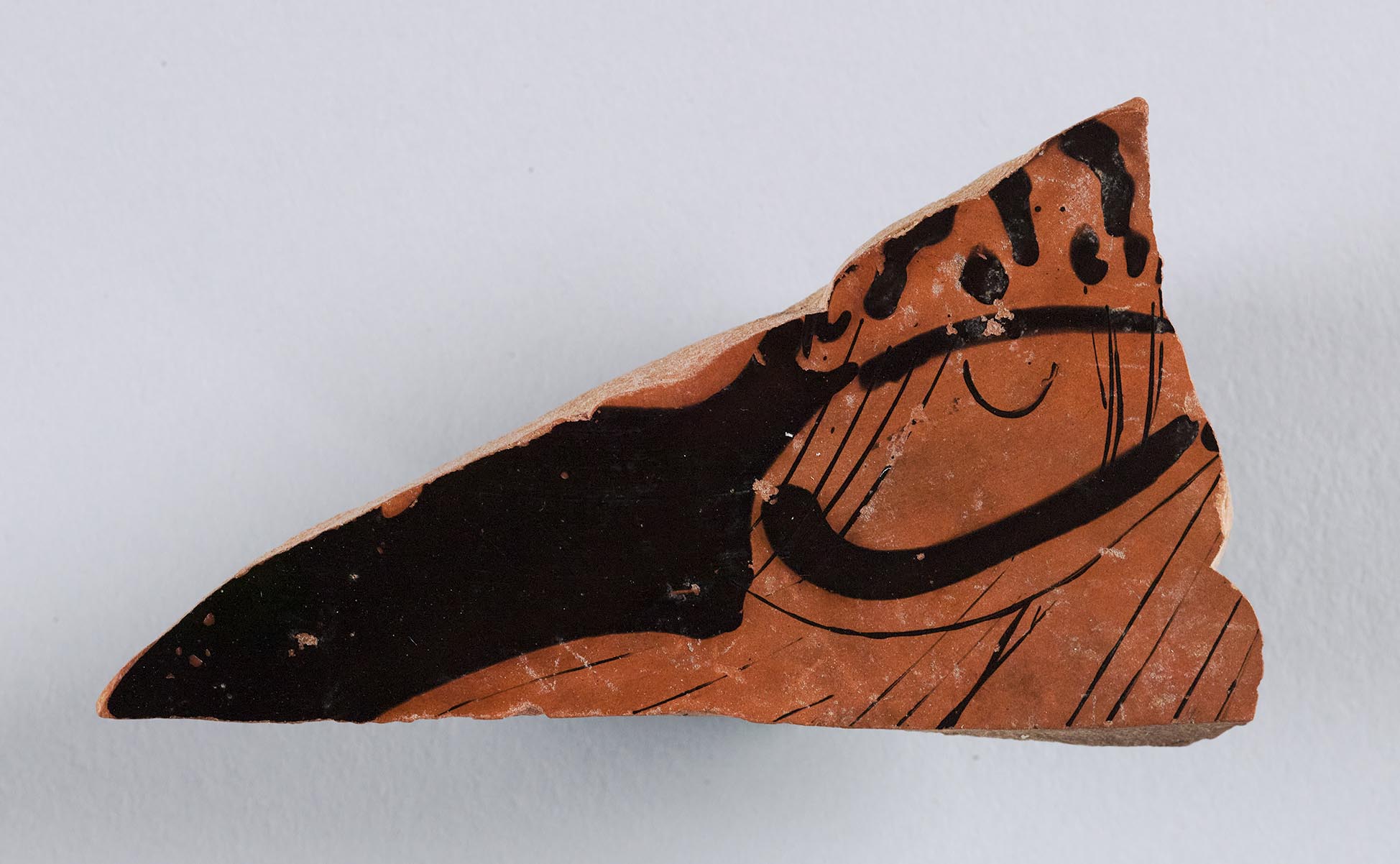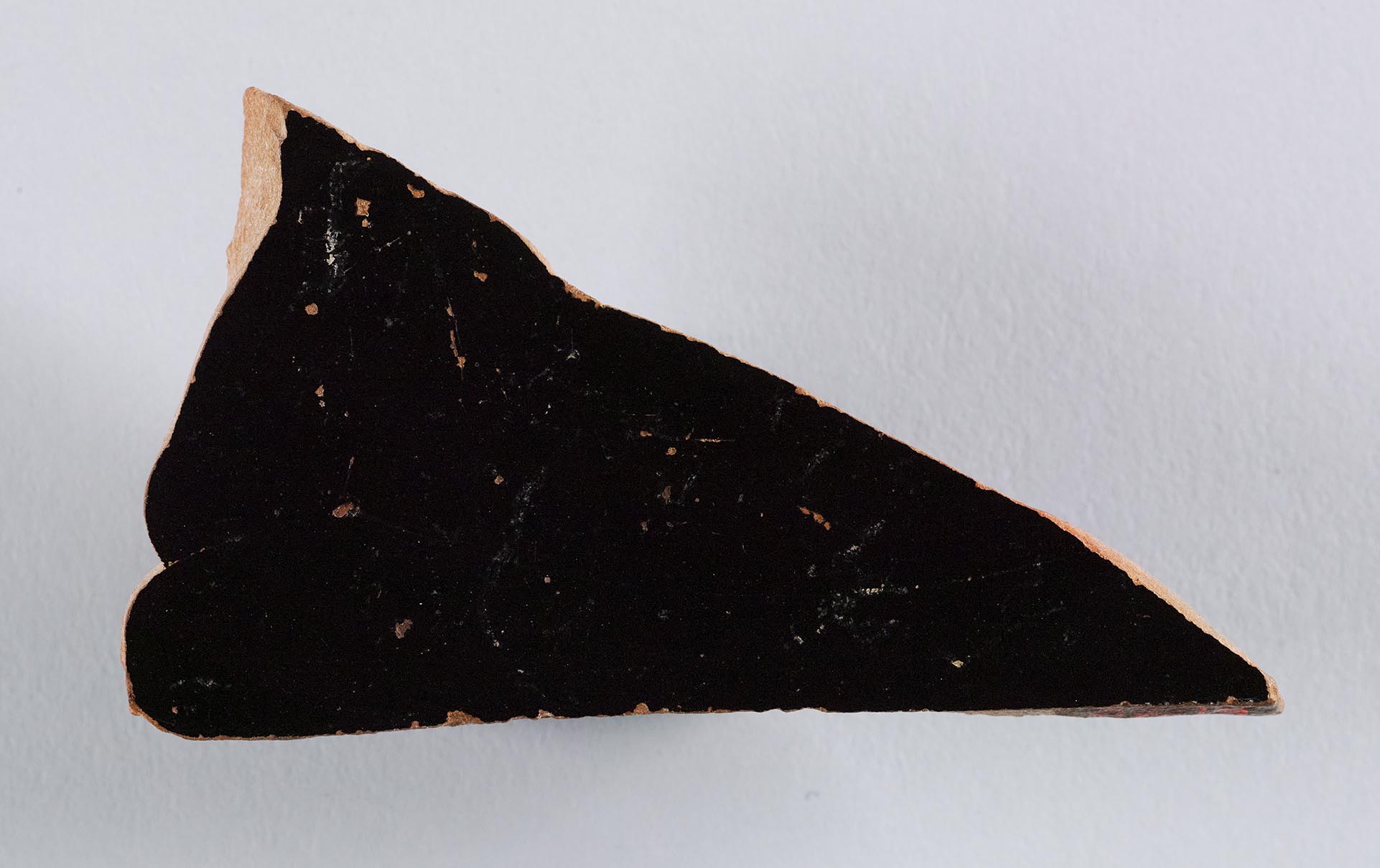Provenance
1986, gift, Dietrich von Bothmer (Centre Island, NY) to Princeton University.
Shape and Ornament
Single fragment from the nearly flat lid. Interior black. No ornament preserved.

Subject
Woman. The fragment preserves the mid-section of a woman who wears a belted peplos as she rushes to the right. Her torso is frontal. Her flexed right arm is extended to the left—only the elbow is preserved—suggesting that she turned back in that direction. A small reserved area at far left could be part of her hand.
Attribution and Date
Unattributed. Early fourth century BCE.
Dimensions and Condition
6.7 × 3.8 cm; thickness 0.6 cm. Broken on all sides. Minor abrasion on both surfaces.
Technical Features
Small section of relief line contour preserved on the upper part of the peplos, by the woman’s elbow.
Bibliography
Abbreviation: Princeton RecordRecord of the Princeton University Art Museum. (1942– ). 46 (1987): 46 [not illus.].
Comparanda
The rather cursory folds, hem lines, and decorative motifs on the peplos suggest a date in the early fourth century BCE. The posture of the woman, rapidly moving to the right while turning back to the left with an outstretched arm, becomes a stock motif on vases starting shortly before 400 BCE, and often occurs on lekanis lids, particularly those of Beazley’s Otchët Group, a “compact group” of the early fourth century, for which see Abbreviation: ARV2J. D. Beazley. Attic Red-Figure Vase-Painters. 2nd ed. Oxford, 1963 1496–98; Abbreviation: ParalipomenaJ. D. Beazley. Paralipomena: Additions to Attic Black-Figure Vase-Painters and to Attic Red-Figure Vase-Painters. Oxford, 1971 499; Abbreviation: BAdd2Carpenter, T. H., ed. 1989. Beazley Addenda: Additional References to ABV, ARV2, and Paralipomena. 2nd ed. Oxford: Published for the British Academy by Oxford University Press. 382. These lekanides commonly feature a combination of a seated woman or women, Eros, and, “very noticeable, a maid running to right, looking round” (Abbreviation: ARV2J. D. Beazley. Attic Red-Figure Vase-Painters. 2nd ed. Oxford, 1963 1496). Beazley separately listed a group of “nuptial lekanides,” in which the addition of a seated naked youth and/or nuptial vessels suggest that the seated woman is a bride; in these, too, “[a] key figure is the zealous maid” (Abbreviation: ARV2J. D. Beazley. Attic Red-Figure Vase-Painters. 2nd ed. Oxford, 1963 1498), epitomized by the woman on Princeton’s fragment, who, like her counterparts, may have carried in one hand or both some combination of a towel, cista, or vessel. With only part of the maid preserved, we cannot know whether this was a nuptial lekanis, as defined by Beazley, but it finds more than a few good parallels within the Otchët Group; e.g., Athens, Agora P 1426 (M. B. Moore, Attic Red-Figured and White-Ground Pottery, Abbreviation: AgoraAthenian Agora (Princeton 1953– ) 30 [Princeton, NJ, 1997], 283–84, no. 1101, pl. 105); Thessaloniki 38.216 (Abbreviation: ARV2J. D. Beazley. Attic Red-Figure Vase-Painters. 2nd ed. Oxford, 1963 1497.18; Abbreviation: BAPDBeazley Archive Pottery Database. http://www.beazley.ox.ac.uk 230800). Aside from the Otchët Group and the Group of Nuptial Lekanides, Beazley also identified several individual hands, including the Painter of Salonica 38.290, on whose name-vase occurs a fast-moving woman with a very similar peplos: Thessaloniki 38.290 (Abbreviation: ARV2J. D. Beazley. Attic Red-Figure Vase-Painters. 2nd ed. Oxford, 1963 1500.1; Abbreviation: BAPDBeazley Archive Pottery Database. http://www.beazley.ox.ac.uk 230848). Too little remains, however, to assign the Princeton fragment to one of Beazley’s individual hands, who often resemble the painters of the Otchët Group.
For lekanides, see B. A. Sparkes, L. Talcott, and G. M. A. Richeter, Black and Plain Pottery of the 6th, 5th, and 4th Centuries B.C.: Part 1; Text, Abbreviation: AgoraAthenian Agora (Princeton 1953– ) 12 (Princeton, NJ, 1970), 164–73, for lids, in particular, see 167–68; Abbreviation: AgoraAthenian Agora (Princeton 1953– ) 30, 54–55; E. D. Breitfeld-von Eickstedt, Attisch rotfigurige und schwarzgefirnißte Lekanides (Wiesbaden, 2017). In the course of the fifth and fourth centuries, the lekanis lid becomes increasingly flat, placing this piece in the later part of the development. The figural decoration on lekanis lids almost invariably continues without interruption around the lid, and this was likely the case on Princeton’s fragment.

